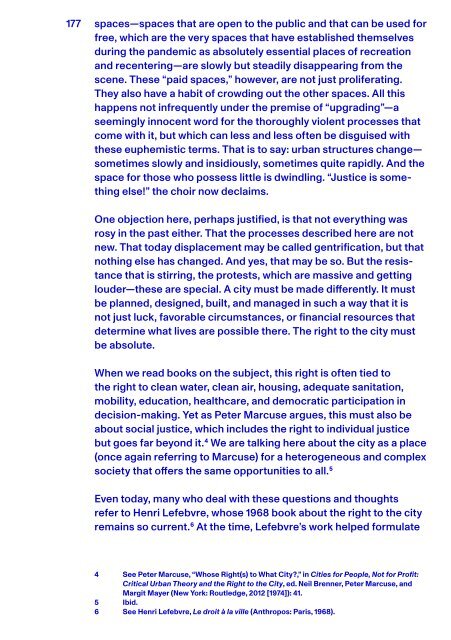Post-pandemic Urbanis
ISBN 978-3-86859-710-3
ISBN 978-3-86859-710-3
You also want an ePaper? Increase the reach of your titles
YUMPU automatically turns print PDFs into web optimized ePapers that Google loves.
177 spaces—spaces that are open to the public and that can be used for<br />
free, which are the very spaces that have established themselves<br />
during the <strong>pandemic</strong> as absolutely essential places of recreation<br />
and recentering—are slowly but steadily disappearing from the<br />
scene. These “paid spaces,” however, are not just proliferating.<br />
They also have a habit of crowding out the other spaces. All this<br />
happens not infrequently under the premise of “upgrading”—a<br />
seemingly innocent word for the thoroughly violent processes that<br />
come with it, but which can less and less often be disguised with<br />
these euphemistic terms. That is to say: urban structures change—<br />
sometimes slowly and insidiously, sometimes quite rapidly. And the<br />
space for those who possess little is dwindling. “Justice is something<br />
else!” the choir now declaims.<br />
One objection here, perhaps justified, is that not everything was<br />
rosy in the past either. That the processes described here are not<br />
new. That today displacement may be called gentrification, but that<br />
nothing else has changed. And yes, that may be so. But the resistance<br />
that is stirring, the protests, which are massive and getting<br />
louder—these are special. A city must be made differently. It must<br />
be planned, designed, built, and managed in such a way that it is<br />
not just luck, favorable circumstances, or financial resources that<br />
determine what lives are possible there. The right to the city must<br />
be absolute.<br />
When we read books on the subject, this right is often tied to<br />
the right to clean water, clean air, housing, adequate sanitation,<br />
mobility, education, healthcare, and democratic participation in<br />
decision-making. Yet as Peter Marcuse argues, this must also be<br />
about social justice, which includes the right to individual justice<br />
but goes far beyond it. 4 We are talking here about the city as a place<br />
(once again referring to Marcuse) for a heterogeneous and complex<br />
society that offers the same opportunities to all. 5<br />
Even today, many who deal with these questions and thoughts<br />
refer to Henri Lefebvre, whose 1968 book about the right to the city<br />
remains so current. 6 At the time, Lefebvre’s work helped formulate<br />
4 See Peter Marcuse, “Whose Right(s) to What City?,” in Cities for People, Not for Profit:<br />
Critical Urban Theory and the Right to the City, ed. Neil Brenner, Peter Marcuse, and<br />
Margit Mayer (New York: Routledge, 2012 [1974]): 41.<br />
5 Ibid.<br />
6 See Henri Lefebvre, Le droit à la ville (Anthropos: Paris, 1968).


















